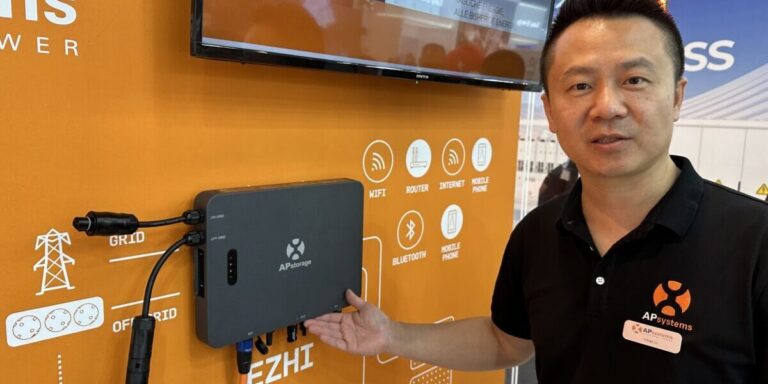Yihan Li, sales manager of AP Systems for Austria and Germany, will present the manufacturer’s new hybrid inverter at Intersolar.
Image: Marian Willuhn/pv magazine
AP Systems has unveiled a true hybrid inverter for balconies. In most cases, balcony power installations use microinverters with batteries connected via an MC4 connector, says Yihan Li, sales manager of AP Systems for Austria and Germany.
The EZHI, on the other hand, is a full-fledged, single-phase hybrid inverter. The system can absorb 1,200 W and supply the same amount again, reducing the feed-in to the grid to 800 W. The hybrid inverter stores the difference in a battery. In off-grid mode, the EZHI can continuously supply the household electricity grid with 2,400 W. The switching time to off-grid mode would be less than 10 milliseconds. According to AP Systems, the system uses gallium nitride semiconductors. Despite the low asset class, the return is 96.2%. Gallium nitride semiconductors are still only used in low-power applications.
The inverter can connect modules with a maximum short-circuit current of 25 amperes. The voltage at the DC input can be a maximum of 60 volts per input. What is special is that alternating voltage can also be applied to the input. For example, if you want to retrofit a battery, you can run the old microinverter and simply connect the AC output directly to the hybrid inverter.
The inverter is certified with protection class IP67 and is therefore ideal for outdoor use. The recommended operating temperature is between minus 40 C and plus 65 C.
The main difference between a conventional balcony inverter and the hybrid solution is that the hybrid inverter has a CAN interface for the battery. This is to ensure better and safer battery operation, says Li. The interface allows the use of only one cable for power transmission and communication with the battery management system. AP Systems does not produce its own battery for balconies, “but we have already tested compatibility with more than 40 manufacturers,” Li adds.
The own app can monitor energy flows and manage self-consumption. Other accessories can be integrated via Wi-Fi and Bluetooth. The manufacturer offers a 12-year warranty on the micro-hybrid inverter.
This content is copyrighted and may not be reused. If you would like to collaborate with us and reuse some of our content, please contact: editors@pv-magazine.com.


